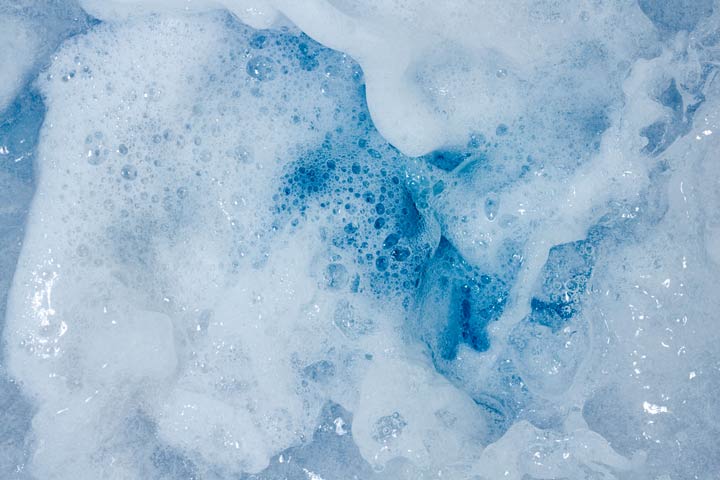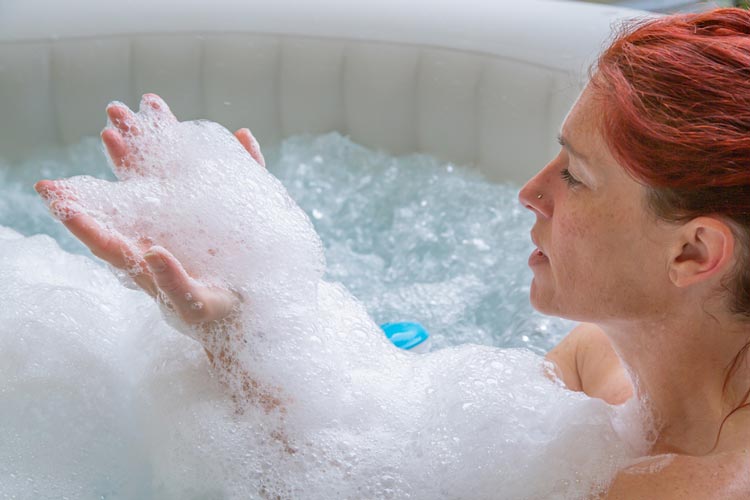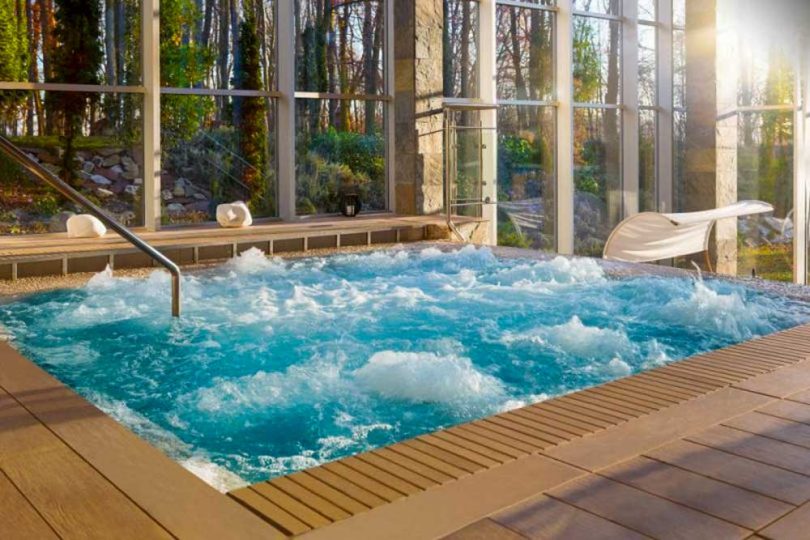Hot tub foam is caused by the ineffective sanitizing of your hot tub frequently after multiple bathers use it. It is actually the most common hot tub problem.
Here we will look at what causes hot tub foam, what to do if this happens, and how to prevent it in the future.
Defining Hot Tub Foam
Hot tub foam is a product build-up (shampoo, lotion, etc.) and totally dissolved solid that cause the water to thicken. When you turn on the hot tub, the air jets whip up these tiny bubbles that create foam.
Foam in a Hot Tub: Should You Be Worried?
Hot tub foam is dangerous and health concern. It is a sign that the hot tub has not been adequately sanitized, and bacteria are lurking in the water. So do not get in that hot tub!
How to Differentiate Between Bubbles and Foam
Step 1: Make Sure to Turn on All the Water Jets
Turn on the hot, give the hot tub motor a chance to work, then turn on all hot tub’s jets and allow them to run for 3-5 minutes.
Step 2: See If Bubbles and Foam Form
You should immediately see the jets churning up bubbles; on the edges of the hot tub, you should see foam similar to what you might see on the ocean edge.
Step 3: Water Jets Off
Turn off the jets and then the hot tub and wait about five minutes.
Step 4: Safety Tip: Unplug from Power Sour
Make sure you unplug the hot tub from the power source so the filter cycle doesn’t kick on.
Step 5: Check the Water for Bubbles or Foam
- Bubbles go away on their own
Check the water as the bubbles and foam dissipate. The bubbles will disappear as the water clears.
- Foam will linger and stay
After the water is clear and the bubbles are gone, the stuff floating on the water is foam. Remove this using a skimmer.
What Causes Hot Tub Foam

1. Build-Up of Biofilm
Biofoam is a build-up of bacteria introduced into your hot tub by the bathers and things that fall in the hot tub (leaves, pollen, etc.).
It thrives in hot dark places and forms in the pipes and plumbing of your hot tub and poses a health threat because it is bacteria. If untreated, the hot tub water will become cloudy, foamy, and have a foul smell.
Biofilm is only removed if you empty the hot tub, sanitize it and do a biofilm treatment that will get into the pipes and plumbing and eliminate the bacteria. You will need routine biofilm treatments to keep this from happening again.
2. Using Soaps and Detergents
Soaps that come off bathers and detergent from their bathing suits can cause cloudy, foamy water in the hot tub.
3. Water Balance Issues
The pH in your hot tub should be perfect, or the water will become foamy. Use your hot tub chemical kit to test the pH of the water.
Once you know if the water is alkaline or acidic, you will know what chemical to use to treat the hot tub. Then test the hot tub weekly and when you have multiple bathers in the hot tube.
4. Using Oils and Lotions
Oil from a bather’s skin, skin cells, and lotion all come off the skin when you sit in a hot tub, leading to biofilm.
To counteract this, you shock the hot tub water weekly and when you have more bathers than usual.
How to Prevent Hot Tub Foam

1. Keep Long Hair Up
Keep shampoo, conditioner, and hair oil out of the hot tub, ask your long-haired bathers to pin their hair up so it doesn’t get in the water.
2. Shower Before the Hot Tub Soak
Have your guests shower before getting in the hot tub. This will remove skin oils, lotions, shampoos, and other contaminants from their skin. Also, have them bring their bathing suit and shower in it will ensure no detergent is in the bathing suit.
3. Use the Best chemicals
Use quality chemicals recommended for hot tubs. Use these chemicals as directed. Do not skimp. It will cost you more money to fix a biofilm problem than it would to buy the chemicals to treat it!
4. Open Your Hot Tub Cover Regularly
The more your hot tub is uncovered, the more likely it will get contaminated. Keep the cover out of the reach of pets and children.
As long as you use the hot tub 3-4 times a week, you do not have to keep the hot tub uncovered. If you are not using the hot tub regularly, you should open it once a week and leave the cover off to let the hot tub breathe.
5. Wash Your Bathing Suit Regularly
Wash your bathing suit weekly in just water, and use that suit only in the hot tub will help prevent water contamination.
6. Make Sure There’s No Detergent on the Bathing Suit
If you are washing your bathing suit in detergent, be sure to rinse the suit and run it through second rinse cycle to ensure that all the detergent is rinsed out.
7. Get a Tub with A Technologically Advanced Filtration System
A Circulation Pump for your hot tub will stop bacteria growth as it circulates the water 24/7 with very little energy use.
A No-Pass Filtration and Circulation Pump will not only circulate the water 24/7, but pushing it through the filter to remove any contaminants to leave the water clear and cleaner works the best.
8. Use Chlorine-Free Spa Shock (MPS)
To treat organics in the hot tub water, use MPS weekly and leave the cover off to prevent chemical gas build-up.
9. Drain Your Tub
a) Draining with a Hose
Step 1: Remove the filters, turn on all the jets, and pour the recommended amount of pipe cleaner into the filter housing. Let the jets run for 15-30 minutes.
Step 2: Once the pipes are clean, turn off the power to the hot tub at the circuit breaker.
Warning: Letting the jets run in a dry, hot tub will ruin them.
Step 3: Locate the primary drain valve on the tube (may be situated on the bottom of the panel or on a corner.)
Step 4: When using a garden hose, make sure that it is draining away and downhill preferably, to a drain or sewer, to keep the damage to your lawn to a minimum.
Step 5: Open the ball valve on the hot tub and let the water drain.
b) Draining with a submersible pump (drains the tub in 10 minutes)
Step 1: Flush the pipes before draining the hot tub (see step 1 above.)
Step 2: Using the circuit breaker, turn off the hot tub.
Step 3: In the deepest part of the hot tub is where you want to place the submersible pump.
Step 4: Attach the hose to the drain to empty out the water.
Step 5: Turn on the pump allows the hot tub to drain.
Step 6: Once the hot tube is empty, remove, clean, and dry your pump and put it away. If you have a bit of water left in the tub (some pumps will only remove so much water and leave a bit at the bottom), you can use the wet/dry vac to suck out the rest.
Step 7: Make sure you clean out the pipes and filter case.
Step 8: Then wipe down the hot tub interior with a soft dry cloth. Finally, you are ready to refill the tube. See the video
10. Clean and Refill Your Hot Tub
Step 1: Once the tub is empty (if you want the tub to be completely empty, you may have to use a wet/dry vac), wipe down the inside of the hot tub with a soft clean cloth.
Step 2: Make sure to wipe out the filter casing as well.
Step 3: Clean the filters so they are ready to replace when the tub is full.
Step 4: Place the hose in the filter casing (filling the tub’s pipes before the tub will prevent air lock that will prevent water from getting in the pipes.) If an “error” light flashes when you have filled the hot tub and turned it on, this is probably air lock, and you will need to call the dealer.
Step 5: Place the filter in the casing once the tub is filled, then the hot tub is ready.
11. Do Not Allow Food or Drink In the Tub
Do not eat or drink in the hot tub; food and beverage falling in the hot tub will change the chemical balance and lead to biofilm.
Is the Water Too Soft or Too Hard?
Both soft and hard water can lead to biofilm.
Soft water will increase and encourage foaming in your hot tub because the calcium level is too low.
Hard water causes scale build-up because the calcium is too high.
How to Know When the Water is Too Soft?
Water Supplier and Neighbors
Ask a neighbor or your local water supplier if the water source you are using is too soft.
Showerheads Build Calcium
Look at the showerhead in your bathroom; if there is a flaky white build-up where the water comes out of the holes, you have calcium build, a sign that your water is hard.
How to Fix Hot Tub Foam?
Do a Weekly Shock Treatment
Shocking the hot tub weekly will kill any starting bacteria and allow the filter to filter it out of the water to prevent foam. Be sure to leave the cover off to avoid a build-up of harmful gas.
Quick Fix: Defoamer or Anti-Foam
To get the foam out of the hot tub in a hurry, skim the foam off the hot tub, and with the jets on, place a few drops of Defoamer /Anti-Foam into the filter casing. Wait approx 5 mins; if there is still some foam, drop a few more drops of the same in the water, it should be foam-free now!
Using Zorbies or Water Clarifiers to Remove Organics
Water clarifiers and Zorbies can help remove organic leaves and bugs from hot tub water.
Keeping the Alkaline Balanced
Test the hot tub for alkalinity at least weekly will help you maintain a good chemical balance at all times.
Hot Tub Maintenance Recommendations
Sustain good water circulation
The more the water circulates, the less likely you will get foam or biofilm.
Maintain a good chemical balance
The perfect chemical balance will stop bacteria from growing.
Have a regular cleaning schedule
Regularly cleaning the hot tub, plumbing, and filters will stop bacteria growth and biofilm.
Bathing Recommendations
Using the following surfactants on your hot tube will increase foam and could result in biofilm:
- Bubble bath
- Epsom salts
- Bath Bombs








Leave a Comment